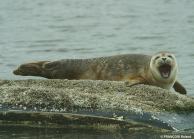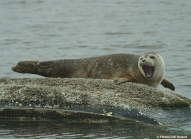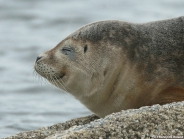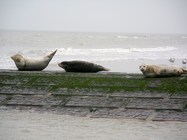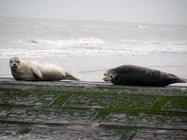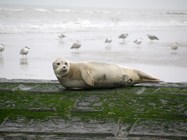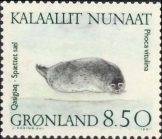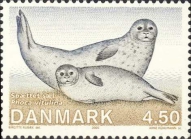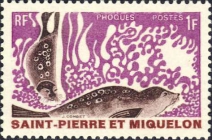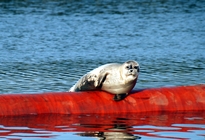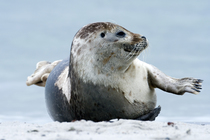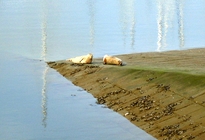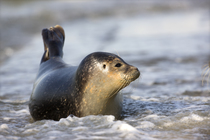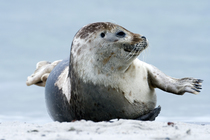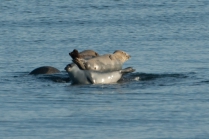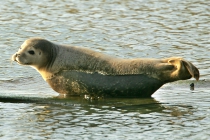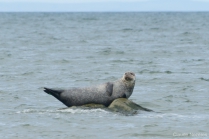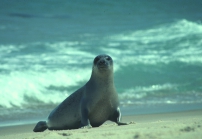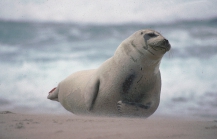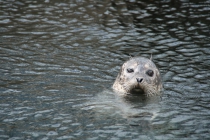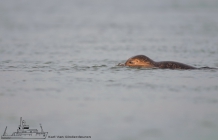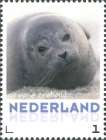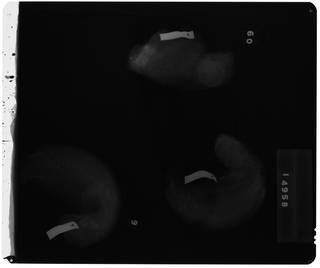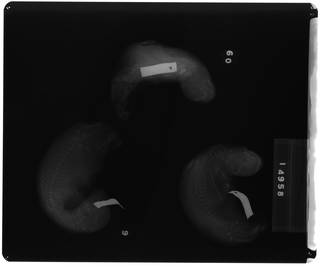CaRMS taxon details
Phoca vitulina Linnaeus, 1758
137084 (urn:lsid:marinespecies.org:taxname:137084)
accepted
Species
- Subspecies Phoca vitulina concolor De Kay, 1842
marine, brackish, fresh
Linnaeus, C. (1758). Systema Naturae per regna tria naturae, secundum classes, ordines, genera, species, cum characteribus, differentiis, synonymis, locis. [The system of nature through the three kingdoms of nature, according to classes, orders, genera, species, with characters, differences, synonyms, places.]. <em>Impensis Direct. Laurentii Salvii. Holmiae [Stockholm].</em> 1(10) [iii], 824 p., available online at https://biodiversitylibrary.org/page/726886
page(s): 38 [details] Available for editors
page(s): 38 [details] Available for editors
Distribution North America
Distribution North America [details]
CaRMS (2021). Phoca vitulina Linnaeus, 1758. Accessed at: http://www.marinespecies.org/CaRMS/aphia.php?p=taxdetails&id=137084 on 2025-05-21
Nozères, C., Kennedy, M.K. (Eds.) (2025). Canadian Register of Marine Species. Phoca vitulina Linnaeus, 1758. Accessed at: https://www.marinespecies.org/Carms/aphia.php?p=taxdetails&id=137084 on 2025-05-21
Date
action
by
original description
Linnaeus, C. (1758). Systema Naturae per regna tria naturae, secundum classes, ordines, genera, species, cum characteribus, differentiis, synonymis, locis. [The system of nature through the three kingdoms of nature, according to classes, orders, genera, species, with characters, differences, synonyms, places.]. <em>Impensis Direct. Laurentii Salvii. Holmiae [Stockholm].</em> 1(10) [iii], 824 p., available online at https://biodiversitylibrary.org/page/726886
page(s): 38 [details] Available for editors
context source (BeRMS 2020) Research Institute for Nature and Forest (INBO). European Seabirds at Sea - data collected by the Research Institute for Nature and Forest (INBO). INBO Seabird distribution data (all trips). [details]
basis of record Mead, J. G.; Brownell, R. L. Jr. (2005). Cetacea. <em>In Wilson, D.E. & D.M. Reeder (eds). Mammal Species of the World. A Taxonomic and Geographic Reference (3rd ed), Johns Hopkins University Press, 2,142 pp.</em> 723--743., available online at http://www.bucknell.edu/msw3/ [details]
additional source van der Land, J. (2001). Tetrapoda, <B><I>in</I></B>: Costello, M.J. <i>et al.</i> (Ed.) (2001). <i>European register of marine species: a check-list of the marine species in Europe and a bibliography of guides to their identification. Collection Patrimoines Naturels,</i> 50: pp. 375-376 (look up in IMIS) [details]
additional source Linkletter, L. E. (1977). A checklist of marine fauna and flora of the Bay of Fundy. <em>Huntsman Marine Laboratory, St. Andrews, N.B.</em> 68: p. [details]
additional source Thomas, M. L. H. (1983). Marine and coastal systems of the Quoddy Region, New Brunswick. <em>Canadian Special Publication of Fisheries and Aquatic Sciences.</em> 64:1-306. [details] Available for editors
additional source Waring, G.T., J.M. Quintal and C.P. Fairfield (eds.). 2002. U.S. Atlantic and Gulf of Mexico marine mammal dtock assessments, 2002. NOAA Technical Memorandum NMFS- NE- 169. 318 p. [details]
additional source Wilson, D. E.; Reeder, D. M. (1993). Mammal species of the world. <em>Smithsonian Institution Press.</em> , available online at http://vertebrates.si.edu/mammals/msw/ [details]
additional source Muller, Y. (2004). Faune et flore du littoral du Nord, du Pas-de-Calais et de la Belgique: inventaire. [Coastal fauna and flora of the Nord, Pas-de-Calais and Belgium: inventory]. <em>Commission Régionale de Biologie Région Nord Pas-de-Calais: France.</em> 307 pp., available online at http://www.vliz.be/imisdocs/publications/145561.pdf [details]
ecology source Looby, A.; Erbe, C.; Bravo, S.; Cox, K.; Davies, H. L.; Di Iorio, L.; Jézéquel, Y.; Juanes, F.; Martin, C. W.; Mooney, T. A.; Radford, C.; Reynolds, L. K.; Rice, A. N.; Riera, A.; Rountree, R.; Spriel, B.; Stanley, J.; Vela, S.; Parsons, M. J. G. (2023). Global inventory of species categorized by known underwater sonifery. <em>Scientific Data.</em> 10(1). (look up in IMIS), available online at https://doi.org/10.1038/s41597-023-02745-4 [details]
page(s): 38 [details] Available for editors
context source (BeRMS 2020) Research Institute for Nature and Forest (INBO). European Seabirds at Sea - data collected by the Research Institute for Nature and Forest (INBO). INBO Seabird distribution data (all trips). [details]
basis of record Mead, J. G.; Brownell, R. L. Jr. (2005). Cetacea. <em>In Wilson, D.E. & D.M. Reeder (eds). Mammal Species of the World. A Taxonomic and Geographic Reference (3rd ed), Johns Hopkins University Press, 2,142 pp.</em> 723--743., available online at http://www.bucknell.edu/msw3/ [details]
additional source van der Land, J. (2001). Tetrapoda, <B><I>in</I></B>: Costello, M.J. <i>et al.</i> (Ed.) (2001). <i>European register of marine species: a check-list of the marine species in Europe and a bibliography of guides to their identification. Collection Patrimoines Naturels,</i> 50: pp. 375-376 (look up in IMIS) [details]
additional source Linkletter, L. E. (1977). A checklist of marine fauna and flora of the Bay of Fundy. <em>Huntsman Marine Laboratory, St. Andrews, N.B.</em> 68: p. [details]
additional source Thomas, M. L. H. (1983). Marine and coastal systems of the Quoddy Region, New Brunswick. <em>Canadian Special Publication of Fisheries and Aquatic Sciences.</em> 64:1-306. [details] Available for editors
additional source Waring, G.T., J.M. Quintal and C.P. Fairfield (eds.). 2002. U.S. Atlantic and Gulf of Mexico marine mammal dtock assessments, 2002. NOAA Technical Memorandum NMFS- NE- 169. 318 p. [details]
additional source Wilson, D. E.; Reeder, D. M. (1993). Mammal species of the world. <em>Smithsonian Institution Press.</em> , available online at http://vertebrates.si.edu/mammals/msw/ [details]
additional source Muller, Y. (2004). Faune et flore du littoral du Nord, du Pas-de-Calais et de la Belgique: inventaire. [Coastal fauna and flora of the Nord, Pas-de-Calais and Belgium: inventory]. <em>Commission Régionale de Biologie Région Nord Pas-de-Calais: France.</em> 307 pp., available online at http://www.vliz.be/imisdocs/publications/145561.pdf [details]
ecology source Looby, A.; Erbe, C.; Bravo, S.; Cox, K.; Davies, H. L.; Di Iorio, L.; Jézéquel, Y.; Juanes, F.; Martin, C. W.; Mooney, T. A.; Radford, C.; Reynolds, L. K.; Rice, A. N.; Riera, A.; Rountree, R.; Spriel, B.; Stanley, J.; Vela, S.; Parsons, M. J. G. (2023). Global inventory of species categorized by known underwater sonifery. <em>Scientific Data.</em> 10(1). (look up in IMIS), available online at https://doi.org/10.1038/s41597-023-02745-4 [details]
 Present
Present  Inaccurate
Inaccurate  Introduced: alien
Introduced: alien  Containing type locality
Containing type locality
Unreviewed
Biology Harbour seals are good swimmers. The pinipeds serve as rudder. The body and back pinnipeds cause propulsion. The seal is highly adapted to speed with its torpedo-like body and pinna. Observations made from ships revealed that they generally swim just 10 m beneath the water surface and that only rarely will they hunt under –20 m.Young harbour seals are born on tide-sandbanks between the end of June and mid July, and are required, almost immediately (during high-tide) to be able to swim.
In general, harbour seals feed on benthic fish (such as flounder, sole, cod and whiting), but they must largely be quite opportunistic in regard to what they eat. They may also feed on mussels, crabs and cephalopods. [details]
Diet Fish, crustaceans, squid [details]
Dimensions Length: 170 cm (5'6"); Weight: 155kg (250 lb) [details]
Distribution North America [details]
Habitat nearshore waters of the Atlantic Ocean and adjoining seas above about 30 degrees latitude [details]
Habitat temperate to polar [details]
Importance They are considered pests to most fishing practices, especially herring weirs and Atlantic Salmon aquaculture sites. [details]
Morphology Distinguishing Characteristics: small in size in relation to seals, dog-like face, v-shaped nostrils, colour varies from white to tan to dark brown to red (molttled): [details]
Morphology Harbour seals can reach up to 1.6 m in length and weigh about 120 kilos. Their colour varies from grey to brown with black marks. A characteristic feature is their V-shaped nostrils. [details]
Reproduction Pupping: May-June on rocky ledges. Precocious, swimming shortly after birth; Weaning: ~ 1 month [details]
| Language | Name | |
|---|---|---|
| Bulgarian | Обикновен тюленobiknoven tyulen | [details] |
| Danish | spættet sæl | [details] |
| Dutch | gewone zeehond | [details] |
| English | harbour sealcommon seal | [details] |
| French | phoque veau-marinphoque veau marin | [details] |
| German | Seehund | [details] |
| Italian | foca comune | [details] |
| Japanese | ゼニガタアザラシ | [details] |
| Lithuanian | paprastasis ruonis | [details] |
| Modern Greek (1453-) | Φώκια των λιμανιών | [details] |
| Norwegian Bokmål | steinkobbefjordsel | [details] |
| Norwegian Nynorsk | steinkobbefjordsel | [details] |
| Polish | foka pospolita | [details] |
| Russian | тюлень | [details] |
| Slovenian | navadni tjulenj | [details] |
| Spanish | foca moteadafoca común | [details] |
| Swedish | knubbsäl | [details] |
| Turkish | liman fokuliman focubayağı fok | [details] |
| Ukrainian | Тюлень звичайнийЗвичайний тюлень | [details] |
| Welsh | morlo cyffredin | [details] |
Marine Life Information Network - UK
To Barcode of Life (34 barcodes)
To Biodiversity Heritage Library (1137 publications)
To Biological Information System for Marine Life (BISMaL)
To Dyntaxa
To European Nucleotide Archive, ENA (Phoca vitulina)
To GenBank (79661 nucleotides; 45696 proteins)
To Global Biotic Interactions (GloBI)
To IUCN Red List (Least Concern)
To NMNH Extant Collection (USNM 14958 Phoca vitulina Radiograph 001)
To PESI
To ITIS
To Barcode of Life (34 barcodes)
To Biodiversity Heritage Library (1137 publications)
To Biological Information System for Marine Life (BISMaL)
To Dyntaxa
To European Nucleotide Archive, ENA (Phoca vitulina)
To GenBank (79661 nucleotides; 45696 proteins)
To Global Biotic Interactions (GloBI)
To IUCN Red List (Least Concern)
To NMNH Extant Collection (USNM 14958 Phoca vitulina Radiograph 001)
To PESI
To ITIS






